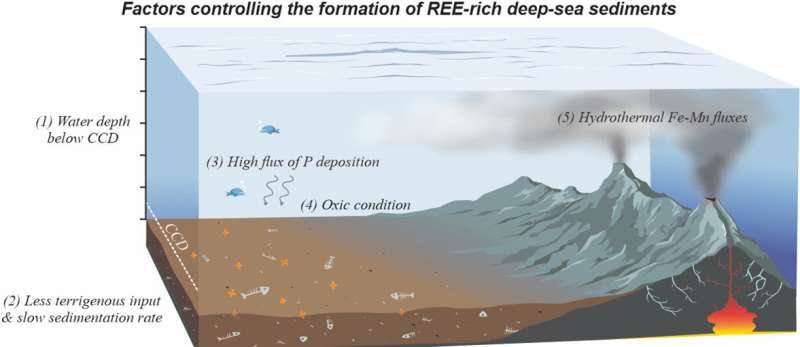Exploring the deep sea as a new source of rare earth elements

Rare earth elements (REEs), like lanthanum and cerium, are vital components in many everyday and emerging technologies, including smartphones, hard disks and clean energy. However, as concerns about the environmental impact of REE extraction and supply chain vulnerabilities grow (China dominates the REE market, accounting for 57.5% of production in 2020), researchers are looking to new sources of REEs.
Pelagic, or deep-sea, sediments are now being explored as a significant potential source of REEs for future exploitation. In a recent paper published in the open access journal Chemical Geology, a team of Chinese and German researchers extracted, analyzed and quantified REEs found in the pelagic sediments of the Tiki Basin in the Southeast Pacific and the Central Indian Ocean Basin.
The researchers used micro-scale methods to analyze the geochemical and mineralogical characteristics of REEs bound to two pelagic carriers: Ca-phosphate, predominantly in the form of bioapatite fossils, and Fe-Mn (oxyhydr) oxides, as micronodule.
Their methods included scanning electron microscope, X-ray diffraction, electron probe micro-analyzer, and laser ablation-inductively coupled plasma mass spectrometry.
The results showed that Ca-phosphate has a dominant role in hosting REEs in the deep-sea environments studied, accounting for ~69.3–89.4% of the total. "The percentages of REE controlled by Fe-Mn (oxyhydr)oxides, mainly as micronodule, are moderate (~8.2% to 22.0%), except Ce (~70.0–80.5%)," observed the researchers.
The study also revealed differences in the quantities of REE found in samples taken from the Tiki Basin and the Central Indian Ocean Basin. This, say the team, indicates that multiple factors—including the productivity of overlying seawater, water depth relative to carbonate compensation depth, and hydrothermal vent input—may be influencing REE enrichment in pelagic sediments.
More information: Jianlin Liao et al, Quantifying the controlling mineral phases of rare-earth elements in deep-sea pelagic sediments, Chemical Geology (2022). DOI: 10.1016/j.chemgeo.2022.120792
Journal information: Chemical Geology
Provided by Springer





















